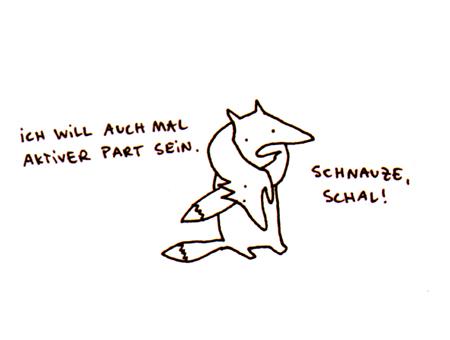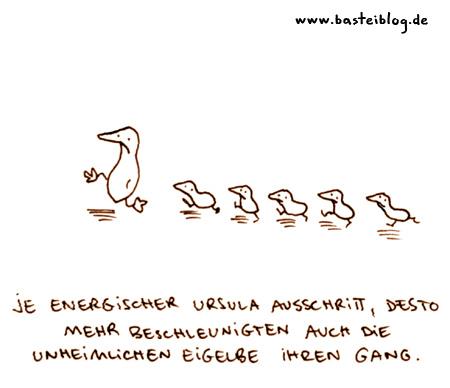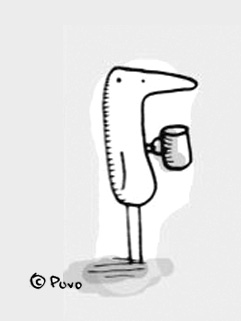
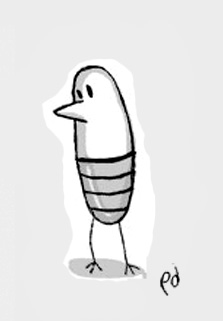
Puvo is an artist from Leipzig, Germany. She joined toonpool.com very early on in Fall 2007. Ed Beals is based in Halifax, Canada. When he became a member in June 2010, I noticed some striking similarities between both of their works. Just look at Puvo’s “Fink” character (left) and Ed’s “birdbee” (right). When thinking about the similarities between their works – apart from their general simplicity and black-and-whiteness – I noticed a quality that I will call “cuteness” for lack of a better term. I asked both of them about this aspect of their cartoons
Would you two agree that your cartoons are “cute”?
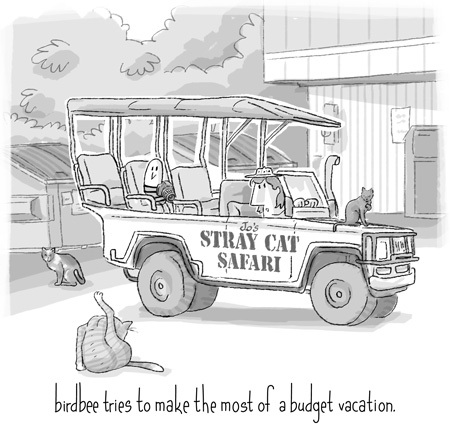
Ed Beals: When I set out to do a cartoon I don’t really think about whether it will be “cute” or not. But that is definitely a description that is often applied to my work. I don’t mind the description, but I hope that they are more than just cute.
Puvo: Yes, I think the “cuteness” thing is true for my cartoons as well. But you need to differentiate between the cuteness of my characters and their general stance toward themselves and other figures in the cartoons. I am trying to use the captions as a counterbalance to the cuteness of the drawings. I wouldn’t say that my characters are exclusively cute. They all share the same problem: they may look adorable, but they are all in a constant struggle with the world.
Why do you do cute cartoons, then?
EB: When I think back to my childhood – back when the earth was still cooling – I used to read a lot of main stream comic books. I was not a big fan of super heroes. I liked horror and I liked funny comics. Back then cute characters were always used for funny stories, and serious or dark stories always used a more realistic style.
As a teenager I drew and wrote my first comic book stories. These were never published, completely amateur productions.. and they were very dark and serious stories. But the characters were cute little animals. I can’t remember now if I consciously set out to work with this contrast, or if it just happened. Maybe it was just the result of being very insecure about my ability to draw in a more naturalistic mode.
PV: I don’t care too much about super heroes myself. There’s a certain kind of self-irony I find in Ed’s work and mine that’s missing in superhero comics. It’s also often missing from ‘naturalistic’ comics… At least I haven’t found any evidence to the contrary yet. Self-irony, on the other hand, works great with cute-looking characters.
The ‘formal’ cuteness of my characters probably results from my style of drawing. I am trying to use as little lines as possible. This also means that I am facing some limitations when it comes to gestures and facial expressions. For some reason the character always look cute in the end. To be honest, I am often unhappy with characters that are supposed to look ‘mean’ or ‘ugly’.
So, Ed, both of you seem to agree that the cuteness is induced by a non-naturalistic style. Most of your stuff that I have seen so far follows the tenet of reducing shapes to their simpler forms. Have you meanwhile gained confidence in your more ‘naturalistic’ works? Do you also draw stuff like real people, monsters, explosions, etc?
EB: As a freelance designer/illustrator/animator, I have had to work with all kinds of styles and media. I feel like I can get by in just about any style, but I never really feel like I have mastered any one form.
At any rate, if I sit down to draw just for my own pleasure, it is most likely going to be cartoons. I draw a lot of things that are definitely not cute. Monsters, if you will, grotesque humans, strange and spooky settings. But this work is almost never presented publicly.
Puvo, the drawing style left aside, there’s another feature that I think creates cuteness in both of your cartoons: a certain sadness, melancholy and helplessness in the characters. Would you agree?
PV: It’s definitely true for my own cartoons – and I’d also say that it’s true for Ed’s. I guess that’s why I like them so much. The basic melancholy in my cartoons is certainly a ‘home-grown’ problem. I am not trying to be cute here – no pun intended – but many of my characters’ traits are traits I find in myself, too.
Back in my younger days I was your typical self-pitying melancholic teenager. In these kinds of situations you experiment with different ways of artistic expression. At some point you will stick with something that helps you to create something useful from all the self-pity. For me this was doing cartoons.
In the beginning, my drawings were rather dramatic – pathetic, actually – and often done in a more realistic way. When I was old enough to grasp the concept of self-irony, my drawings turned more humoristic. And that’s where I think I am still at. Even if the characters remain helpless and melancholic, there’ always a hint of self-ironic humor.
Ed, are your cartoons based on your own person, too?
EB: My birdbee series definitely has an element of reality. Although birdbee is a simple, non-human character, the world of birdbee is very much rooted in the reality of my world. The locations are based on my own home and city. birdbee’s thoughts are mostly my own.
While I explore some of the more insecure and fragile aspects of the human mental landscape, it’s not all gloomy. I try to balance the serious side with humour and even the absurd. Just like real life.
When looking at “birdbee” I felt reminded of James Kochalka’s “American Elf” diary strip. He also has this balance between the serious side of life and funny things. And his drawings are somewhat cute. Do you see any connections between your works?
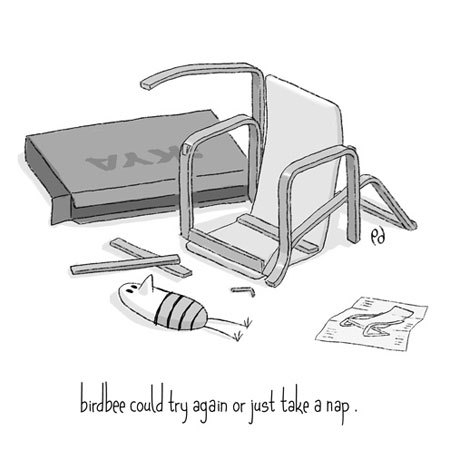
EB: Kochalka’s work is achieving things to which I aspire, so I will take your comparison as a compliment! His approach seems almost like documentary and I find it quite compelling. He is not writing gags and I do not want to write gags either.
Sometimes when I am sketching an idea for a birdbee drawing I will hear a voice in my head saying “but where’s the funny?” I think I am getting better at ignoring that voice.
Puvo, with your cartoons it was Gary Larson’s Far Side that came to my mind. Not so much for the type of gags but for the way both of you make up names for the animal protagonists. I think this adds to the cuteness because they become individuals rather than archetypes. Are there works by other cartoonists that you would say are important for your own work?
PV: I heard about Gary Larson only six months ago – through a cartoon by BECK. But there are of course artists that I admire and who may have influenced my own style of drawing. There’s Lewis Trondheim, for example, Graham Annable and George Herriman. It was through their work that I discovered my love for minimalism.
Regarding the formal structure or my brand of humor, on the other hand, I wouldn’t say that I am influenced by other cartoonists. At least not consciously. Yet every now and then I will discover other works that remind me of my own style. About a year I ago I stumbled upon a book by Bernd Pfarr. Seeing his art was humbling. Just to know that another artist has reached perfection in a field that you have been trying to master for some time.. On the other hand, it also showed me that this kind of humor “works” and that it’s worthwhile spending time on it.
Thanks for your time!
]]>